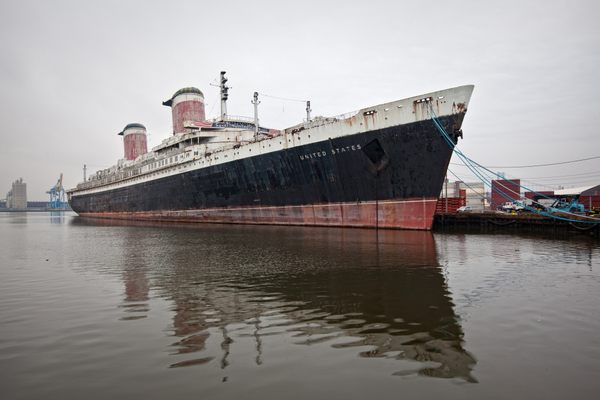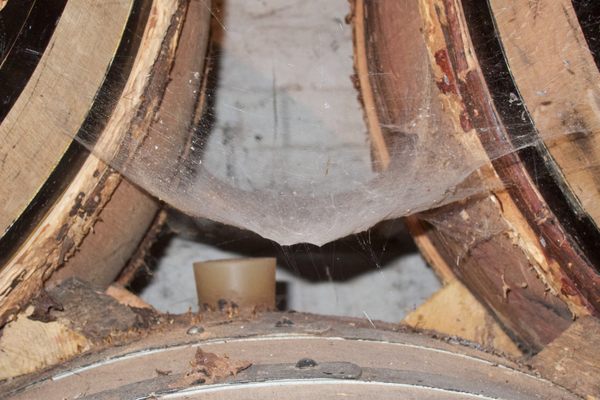A Guide to 5 Ghoulish Ghost Ships
31 Days of Halloween: On Atlas Obscura this month, we’re celebrating Halloween each day with woeful, wondrous, and wickedly macabre tales all linked to a real locale that you can visit, if you dare.
Piloting the ghost ship at Disneyland’s Pirates of the Caribbean ride (photograph by gkaitz/Flickr user)
The term ghost ship has a few accepted definitions out there, the most popular being: a derelict vessel found drifting at sea that once had — but no longer has — living crew members aboard her. There are actually quite a few documented cases throughout history of these haunting ships with crews that just plain vanished. And also a few unverified ones. Here are some of our favorites.
THE MARY CELESTE
Lost whole crew, and nine barrels of wine, mysteriously in 1872
Engraving of the Mary Celeste (via Wikimedia)
Perhaps the best documented of history’s ghost ships, a merchant brigantine called the Mary Celeste was found derelict in the north Atlantic on December 4, 1872, in fine weather, missing its entire crew as well as a lifeboat. She was built in 1861 in Canada and originally christened the Amazon, and before her final voyage 11 years later, she managed to crash into other vessels twice, catch fire in a shipyard during repairs, and run aground during a storm near Glace Bay, Nova Scotia.
The ship was said to be cursed from the start: Her first captain died of pneumonia nine days into her maiden voyage, and two more captains were to die aboard her. In early November of 1872, Captain Benjamin Briggs docked the Mary Celeste in New York City’s East River to pick up his wife, two-year-old daughter, and $35,000 worth of Italian wine, and the crew — now comprising ten people — set off for Genoa. A month later, the Mary Celeste was spotted by the Canadian merchant ship Dei Gratia 600 miles off the Portuguese coast, slightly yawing and with ripped sails. When the Canadian crew boarded her, they found no people and “that the whole ship was a wet mess,” with over three feet of water between decks and two disassembled pumps. Save for the logbook, all of the ship’s papers were missing, as was nine barrels of its alcoholic cargo. The last log entry was 11 days prior. No sign of violence or struggle were discovered.
Mutiny, drunkenness, and piracy were most commonly blamed for the crew’s disappearance, but none of these seemed likely, given that Captain Briggs was well-liked and a known teetotaler who was unlikely to tolerate a drunken crew, and also that the hold contained a six-month supply of uncontaminated food and almost 1,700 barrels of wine, still intact.
No bodies were ever found, and no one ever heard from any of the Mary Celeste’s crew again. Sir Arthur Conan Doyle was instrumental in popularizing the mystery of the ship in the semi-fictional J. Habakuk Jephson’s Statement, which speculates on the crew’s fate. This probably served to discombobulate the mystery even more, though, as many of the details from Doyle’s story were commonly cited as fact thereafter. Following a fruitless admiralty inquest, the Mary Celeste changed hands about 11 times and ended up in severe disrepair, shipping scrap cargo in the Caribbean. In a bid to commit insurance fraud, her last owner purposefully wrecked her off the coast of Haiti in 1885. A monument was later built in Nova Scotia in memory of Captain Briggs and the lost crew.
S.S. OURANG MEDAN
Whole crew discovered dead in 1947 (supposedly), after eerie SOS messages
Skeleton captain by Stephen Oatway in Brighton, Australia (photograph by Michael Coghlan)
An unsubstantiated ghost ship claim, this one is no less terrifying: In 1947, the Dutch cargo ship S.S. Ourang Medan (Indonesian for “Man from Medan”) was found drifting in Indonesian waters. Several ships transversing the Strait of Malacca, located between Sumatra and Malaysia, picked up her distress call that stated “All officers including captain are dead, lying in chartroom and bridge. Possibly whole crew dead.” A flurry of unintelligible Morse code and S.O.S. signals followed, ending with the grisly message: “I die.”
When the Ourang Medan was located and boarded by the crew of an American merchant ship, the Silver Star, the claim didn’t disappoint: the bodies of the Dutch crew were strewn among the decks, out in the open, down in the boiler room, everywhere. “Their frozen faces were upturned to the sun… staring, as if in fear… the mouths were gaping open and the eyes staring,” according to a witness account printed in the United States Coast Guard’s 1952 proceedings. Even the ship’s dog was dead. No damage to the ship was found, and no sign of physical injury was found among the corpses. Other than the fact that they were, you know, dead.
No sooner than the Silver Star’s crew cut the towline and made it back to their vessel, the Ourang Medan exploded. If they’d waited much longer, the Silver Star would have almost certainly been dragged down with it.
Popular theories include carbon monoxide poisoning, paranormal phenomena (of course), and a cargo of hazardous chemicals — possibly a sweet combo of nitrogylcerin and potassium cyanide. However, the story of the Ourang Medan is widely believed to be either an exaggeration of another event or else a fabrication altogether. Skeptics roundly disdain the tale, pointing to the fact that no such ship was listed in Lloyd’s Shipping Register of that year, nor were any references to it were found in the ship registration records of the Netherlands. (It was still alarming enough to spark an investigation by the US Coast Guard, though, with plenty of witnesses, indicating that somebody at least saw something.)
THE TEIGNMOUTH ELECTRON
Ship found empty and drifting at sea in 1969
The Teignmouth Electron decaying on the Cayman Islands (photograph by Packmatt/Flickr user)
This one’s pretty straightforward and mystery-free, but it’s just as chilling: The Teignmouth Electron, a 40-foot trimaran bearing a crew of one, was found empty and derelict in the Atlantic in July of 1969. The boat had been built by Donald Crowhurst, who was taking part in a round-the-world yacht race in hopes of winning a cash prize to support his failing business.
Crowhurst was nowhere to be found, though. It seems that after running into sailing difficulties, he quit the race and began reporting false positions, attempting to secretly circumnavigate rather than actually circling the Earth. Based on his increasingly insane log entries and other evidence, it was surmised that Crowhurst ultimately jumped overboard and drowned. The vessel had been drifting unoccupied through the ocean for over a week.
Eventually after having several subsequent owners, the ship was left to decay on the Cayman Islands.
THE GHOST SHIP OF NORTHUMBERLAND STRAIT
A phantom vessel on fire spotted since 1786
Is this how the ghost ship appears? (photograph of a tall ship in Halifax by Alan Zabicky)
Since 1786, a flaming ship has been sighted regularly in the frigid waters between the Canadian provinces of New Brunswick and Nova Scotia, with a report filed as recently as 2008. Described as a beautiful schooner with white sails and either three or four masts, the mirage is said to show up more frequently in the autumn.
A ball of fire in the sky is often reported as well, along with the sounds of sea guns being fired. Dozens of eyewitness accounts have been documented, with large groups of people all corroborating the same story. The sight is apparently so vivid that more than once, sailors have attempted to rescue the ghost ship’s crew: In 1900, in Prince Edward Island’s Charlottetown Harbour, a group of mariners sent a small vessel toward the phantom ship to bring its crew members aboard, but the ship vanished as they were rowing toward it. No shipwreck was ever found.
HIGH AIM 6
Discovered without its crew, its hull full of rotting fish, in 2002
Flying the flag of death (photograph from Chicago by Bart Heird)
This Chinese ship left southern Taiwan on Halloween of 2002, flying an Indonesian flag, and was discovered drifting in Australian waters, sans its crew, in early January of 2003.
The ship’s owner last spoke with the captain the month before. The hold was discovered to be full of rotting fish, and the engine was dead. After a search for the Indonesian crew that spanned some 7,300 nautical miles (13,500 km), police located only a single crewmember for questioning — he eventually indicated mutiny and that the captain and the ship’s engineer had been murdered, but he was unclear on the details, and the motive remains a mystery. For about a year afterward the forensic investigation, High Aim 6 sat beached on shores of Broome, Western Australia, where it become something of a tourist attraction before being dismantled and sent to the landfill in 2004.
Click here for more of our 31 Days of Halloween, where each day we’re celebrating the strange-but-true unsettling corners of the world. And check in on Facebook, Tumblr, and Twitter to participate in the daily offerings of unsavory Halloween treats.











Follow us on Twitter to get the latest on the world's hidden wonders.
Like us on Facebook to get the latest on the world's hidden wonders.
Follow us on Twitter Like us on Facebook